Green Certification and
the Future of Family Forests
J.P. Caulfield, R. G. Chambers
and C. T. Fields
The authors are Vice
President, President, and Forest Information Specialist, TimberVest, LLC
8744
Main St., Woodstock, GA 30188
Forest certification is a hot topic; it
is difficult to pick up a forestry publication without reading about it. Most writers view it positively and think
America’s forests “need” certification.
This is cause for concern
because it is a huge assumption. It
also happens to be wrong.
Not surprisingly, the newly-growing
“certification industry” sees its need as self-evident. The Forest Stewardship
Council (FSC), for example, markets certification with statements like: “There is huge public concern about the
destruction of the world’s forests.
More and more people demand products that come from well-managed
forests. (Forest Stewardship
Council 2001).
Such generalizations
lack supporting documentation. In fact,
available evidence suggests the opposite: that the public at large does not
“demand” products from well-managed forests if they cost more than what they are
buying now.
The assumption that
America’s forests need certification should concern landowners, because there is
no compelling evidence to suggest America’s forests are in danger. In fact, available evidence suggests the
opposite: that US forests are healthy, diverse, and productive.
Some certification
models represent a base infringement on individual property rights. Their broad acceptance would have precisely
the opposite results proponents claim to want.
They would promote poor forest management, create economically non-viable
forests, and raise income disparities between urban and rural areas.
Certification’s greatest impact would
fall on family forests, which are the nation’s largest timber producers and a
group that has been excluded from the process that gave rise to the
certification industry. Most private
landowners are unfamiliar with the certification issue and what is in store if
it is widely adopted.
“Sustainable” Forestry and the
“Need” for Certification
There is little debate to
suggest whether America’ s forests actually require certification. Proponents argue that forests should be
managed to be “sustainable.”
The notion that forests should
be sustainably managed does not need to be argued, because foresters have always
advocated sustainable forestry. In the
clamor for certification, it is forgotten that creating sustainable forests is
the reason the forestry profession developed in the first place.
But certification proponents
avoid defining “sustainability” because, the more ambiguously it is defined, the
greater the opportunity for the certification industry to view it as a blank
check. This allows the imposition of
standards that are biologically unsound, economically unjustified, and
inconsistent with a capitalist system.
The notion that American forests
“need” certification presumes they are badly managed and declining. Poor management can lead to a
“nonsustainable” condition, where total forest area, productivity, and
biodiversity are reduced. But is this
actually happening?
It depends on the definition of
“sustainable.” Since the certification
industry provides little guidance, we define a sustainable forest as one
capable of providing a continuous supply of forest outputs on a long-term basis.
It is not the only possible definition, but it has the virtue of simplicity
and is relatively unambiguous. It also
allows us to quantitatively measure whether America’s forests are sustainably
managed. Consider the following
questions:
(1) Is
the forest area increasing or declining?
(2) Is
total forest growing stock volume increasing or declining?
(3) Is
per-acre productivity increasing or decreasing?
(4) Are forests regenerated
adequately and in a timely manner?
(5) Is
the volume in large diameter trees increasing or
decreasing?
(6) How does the area of
plantation-grown forests compare to that of natural
forest?

Figure 1 shows total US forestland
acreage since the mid-1800s (USDA Forest Service 2000). Forest area declined from the mid 1800s to
the start of the 20th century in response to the rapid rise in
agricultural land clearing. But since
the first decade of the 20th century, the forest area has been
essentially unchanged. Despite a
growing population and a period of historically unprecedented industrialization,
the US forest land base rose since 1900.
This hints at a sustainable forest condition.
Some would argue that this
increase might include many acres of poorly stocked forests with declining
productivity. If true, it would suggest
forests were not managed sustainably.

Figure 2 shows changes in forest growing
stock volume since 1953 (USDA Forest Service 2000). Volumes on NIPF lands rose 73%. Since the number of forested acres was
almost unchanged, it means per-acre forest productivity rose.
If forest management is
sustainable, harvested acres should be quickly regenerated, so the area of
non-stocked forestland should be low.

Figure 3 shows that 1.5% of US
timberland area was non-stocked in 1997 (USDA Forest Service 2000). Moreover,
the area of unproductive timberland declined dramatically (82%) over the
last half-century. The area in larger,
sawtimber-size trees also rose.
The increase in sawtimber acres
is worth examining in detail.
Certification advocates prefer big trees to small trees because they
consider them better indicators of biodiversity and reflective of the forest
conditions that existed in a less-industrialized era.

Figure 4 shows softwood sawtimber volume, by year and ownership category (USDA Forest Service 2000). Volumes rose steadily on NIPF lands, increasing 60% since 1953. Volume also rose on public lands. Only industrial timberlands witnessed a decline in sawtimber volume.
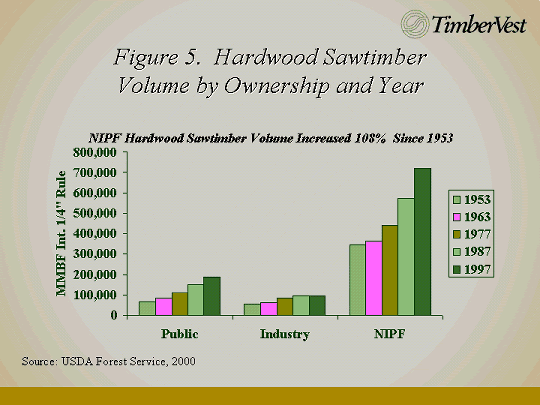
Figure 5 shows that hardwood sawtimber more than doubled on NIPF lands since 1953 (USDA Forest Service 2000). Hardwood sawtimber volumes also increased on both public and industry holdings.
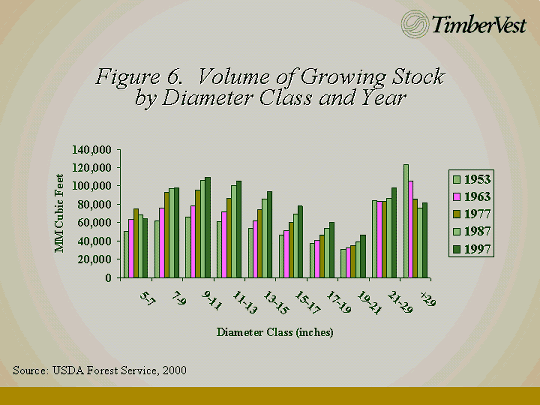
Figure 6 shows total growing stock volume rose in virtually all diameter classes (USDA Forest Service 2000). Not only did sawtimber volume rise, but also in most diameter classes it is now in larger trees. The sole exception is the very largest size classes, (+29” size) category. But even here, the volume rose over the past decade.
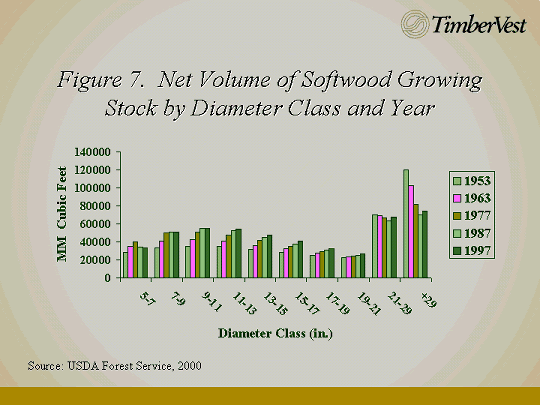
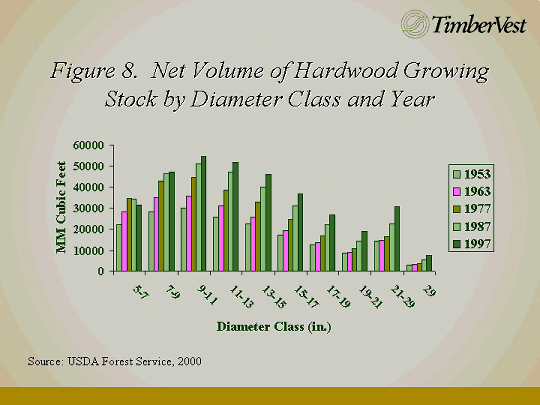
As Figures 7 and 8 show,
the diameter increases have occurred both for softwoods and hardwoods (USDA
Forest Service 2000). For
hardwoods, the proportion of growing stock rose dramatically in all diameter
classes.
Some would argue this picture is
biased because it overlooks the impact of forest plantations. Some members of the certification industry
dislike plantations, because they claim to be concerned that plantations are
replacing natural forests.
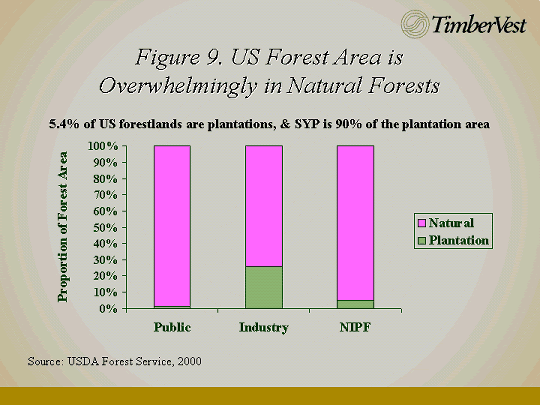
Figure 9 shows that plantations account
for 5.4% of total US forest area. Most
are held by forest industry, which has planted 25% of its timberland area. Just 5.3% of NIPF lands are in plantations,
and 1.2% of public lands are planted.
Globally, the importance of plantations is even more telling. Two independent studies have estimated the proportion of world wood supplies coming from plantations. Caulfield (1998) estimated that between 17 and 22% of world timber supplies come from plantations. Work by Hagler (1997) put it at 18% of total supply.
But worldwide, plantations
account for just over 3% of the world’s forest area. Because plantations grow faster than natural
forests, every plantation acre allows a disproportionately large reduction in
the timber supply burden on natural forests.
This frees natural forest acres to non-consumptive uses.
In short, no compelling case
exists for imposing certification on US forests. America’s forests, in terms of total area,
productivity, tree-size distribution, and proportion of natural versus man-made
forest area are thriving.
Nonetheless, there is increased
interest in certification, and the industry continues to grow. Does certification truly promote sustainable
forestry? There are many certification
schemes; a complete discussion is beyond this article. So let’s consider the three models best
known within the US. These also represent the widest spectrum of views of what
certifying bodies expect of participants.
Certification
Models: The Good, the Sad, and the Ugly
We refer to the three
certification models as “The Good, the Sad, and the Ugly.” These are represented
respectively by the American Forestry Foundation’s American Tree Farm System,
the AF&PA’s Sustainable Forestry Initiative (SFI), and Forest Stewardship
Council (FSC) certification.
The Good: The American Tree Farm
System
The American Tree Farm System
exists “…to provide conservation education to private forestland owners in
the United States….The Tree Farm system goal is to reach out to these landowners
and assist them in managing their forests sustainably” (American Tree
Farm System 2001). The System dates to
1941, and includes over 70,000 US certified tree farms.
Certification is conducted
through the American Forestry Foundation, the oldest and largest voluntary third
party verification group in the United States.
The objective is to “…recognize the practice of excellent forestry on
private forest lands. This certification is intended to raise the visibility of
the practitioners in their respective communities and inspire and motivate other
surrounding non-managing forest landowners to practice sustainable forestry”
(American Tree Farm System 2001).
Three
features set Tree Farm apart from the other systems considered. First, since certification takes place on
individual ownerships, it focuses on factors the owner can actually control, and
in which he has a vested interest. This
is not true with FSC certification, which includes numerous social goals in
their model.
Second,
Tree Farm is the most inclusive of the certification systems considered. Membership is voluntary and open to any
interested timberland owner, but non-members are not discriminated against by
the organization.
Members
are expected to write a forest management plan, regenerate harvested areas
promptly, maintain water quality, and protect and enhance wildlife habitat. But in advocating these practices, the
System imposes relatively few hard and fast rules about precisely how landowners
must perform them.
Properties
are certified through independent third-party foresters. The service is provided on a volunteer
basis, so the certifier operates with no economic conflict of interest.
Third,
Tree Farm certification recognizes that ownership objectives vary. Some landowners prefer to grow pine
plantations while others may manage for wildlife. Tree Farm avoids value judgments about
who is doing the “right” thing, leaving these decisions to the owner. In other words, the Tree Farm System values diversity.
Tree
Farm certification embodies a positive world view because it recognizes that
landowners are rational and want to manage their property to achieve desirable
personal and social goals. It is
consistent with a free enterprise system.
Tree Farm views itself as an
educational organization, not a regulatory bureaucracy. While landowners are assumed to be rational,
Tree Farm understands that initially they may not possess the forestry expertise
needed to effectively manage their properties.
So the organization provides numerous educational opportunities to
overcome this obstacle. In addition to
8,000 volunteer foresters, the Tree Farm system provides publications,
workshops, and field days to help landowners make informed
decisions.
The Sad: The Sustainable Forestry
Initiative
The Sustainable Forestry
Initiative was established by the American Forest & Paper Association
(AF&PA) in 1994, in response to accusations of poor management from
preservationist groups and to more extreme certification models proposed by
groups like FSC. The AF&PA states
that SFI is “….an exacting standard
of environmental principles, objectives and performance measures that integrates
the perpetual growing and harvesting of trees with the protection of wildlife,
plants, soil and water quality and a wide range of other conservation goals.”
(AF&PA 1999).
The SFI, like the Tree Farm
System, advocates “sustainable” forestry, although the term is viewed
vaguely. Operationally, the SFI
promotes forestry that is environmentally responsible and include practices like
(1) promptly regenerating harvested areas, (2) protecting water quality, (3)
conserving biodiversity and wildlife habitat (4), minimizing visual impacts of
harvesting, (5) protecting places of historical, ecological and biological
significance, and (6) improving wood utilization.
But the SFI is “The Sad” for
several reasons. First, it is
reactive. The largest forest products
companies, representing a majority of AF&PA members, have promoted
scientifically sound forestry for decades. By suddenly advocating the “need” for
SFI certification, these firms have basically repudiated the good stewardship
their foresters have practiced for over fifty years.
Industry’s research investments
– tree improvement programs being a single example – have tremendously improved
forest management on industry and family forests alike. The SFI, by ignoring these very real
accomplishments, provides the impression of an industry that has something to
hide.
AF&PA President W. H. Moore
has stated that the SFI, on reaching its fifth anniversary had reached “…an
important reference point for many of the original goals we set when we first
began this ambitious campaign to transform the forest products industry” (AF&PA 1999). It is unclear what the
industry is being transformed from.
It is one thing to strive for improvement, which is an appropriate goal
for any industry. But the AF&PA gives the impression that the forest
products industry pre-1994 is the same industry that existed pre-1894. It
wasn’t.
The SFI is exclusionary.
AF&PA makes SFI compliance a mandatory condition for membership. SFI was
initially marketed by going to the CEOs of the major corporations. When these
firms bought into SFI, by virtue of their market dominance they basically forced
the issue with the rest of the industry. This contrasts sharply to the inclusive
model advocated by Tree Farm.
The AF&PA approach is
contrary to industry’s long-term interests. The SFI suggests to the public that
in past years the industry managed its lands irresponsibly. AF&PA appears to
want to give the impression that it exists as an industry regulating body,
rather than an industry
association.
In fact, the AF&PA actually
brags that: “Sixteen member
companies have been expelled from the Association for failure to uphold the
standard set by the SFI program.” (AF&PA 1999). Leading by edict is a poor substitute
for leading by example, and AF&PA has alienated numerous firms.
Until recently, AF&PA only
tried to impose its standards solely on member firms. More ominously, AF&PA is becoming more
ambitious and attempting to impose SFI certification on US family forests and
foreign timber growers: “We are
revolutionizing industrial forestry in America, and we are beginning to expand
the practice of sustainable forestry beyond our own forests to public and
privately owned forestland, and even to other countries” (AF&PA 1999).
Considering the cavalier
treatment industry has afforded its own members, this is cause for concern.
The
Ugly: The Forest Stewardship
Council
The FSC, established in 1993,
claims that: “The Forest
Stewardship Council is an independent, non-profit organization that promotes
responsible forestry. A standards-setting body for a forest
certification system, the FSC, through its Principles and Criteria for Forest
Management, has established the highest standards for environmentally,
economically and socially responsible forestry” (FSC
2001).
Certification is based on 10 “principles,” intended to
be applied to all forests worldwide, regardless of ecological characteristics
and whether publicly or privately owned.
Certification standards are developed at a regional level by FSC in
conjunction with regional committees.
FSC
certification bundles numerous social goals into the certification process. Consequently, their principles and standards
are ambiguous, arbitrary, and conflicting.
It is best described as a social engineering approach to
certification.
That
the principles apply equally to public and private lands says much about FSC’s
philosophical foundation. Briefly, all
forests are viewed as public goods, except that private landowners are obliged
to pay their own bills and shoulder the risks for those lands.
FSC
certification standards are still being developed for most regions, so our
discussion is limited to the draft forest certification standards for the
southeastern US (FSC 1999). Space does
not allow a complete presentation since the 10 “principles,” and accompanying
details run 37 single-spaced pages. But
some examples are instructive.
Principle 3 addresses Indigenous Peoples, which in part
(section 3.2) states that: “Forest
management shall not threaten or diminish, either directly or indirectly, the
resources or tenure rights of indigenous people.” (FSC 1999).
The
FSC does not consider “indigenous” a family which has managed and inhabited a
property for the last 150 years. Taken
at face value, Principle 3 implies either that a landowner’s property should be
returned to the indigenous group that formerly occupied the land, or that any
proposed management on that land must be approved by the indigenous people who
live nearby.
Principle 4 concerns community relations and worker’s
rights: (4.1) “The communities
within, or adjacent to, the forest management area should be given opportunities
for employment, training and other services” (FSC 1999).
The
extent to which the owner of a 500-acre forest is responsible for employing and
training the local labor force is not made clear. Must he be prepared to pay their college
tuition? What if the landowner knows
the local wood dealer is dishonest? The
principle says the landowner should deal with these people. Most important, this principle has nothing
to do with a well-managed forest.
Section 4.4 states:
“Management planning and operations shall incorporate the results of
evaluations of social impact.
Consultations shall be maintained with people and groups directly
affected by management operations” (FSC 1999).
Landowners are expected to consider local views about
aesthetics, cultural sites, access, employment, and landscape level
impacts. Put another way, any whim of
individuals with no connection to a forest property is placed above the goals of
the landowner who pays all the costs and takes all the risks.
Principle 5 concerns forest benefits: (5.1) “ Forest management should strive
toward economic viability, while taking into account the full environmental,
social and operational costs of production, and ensuring the investments
necessary to maintain the ecological productivity of the forest” (FSC 1999).
It is not clear whether FSC considers a 1% or
a 10% return economically viable. It
does not suggest whether “economic viability”
is the same for all landowners.
How do the certifiers make an objective determination? They cannot, since the principle is
arbitrary.
Section 5.1.2 states “The landowner’s resources
should be sufficient to financially support post-harvest management activities
such as road maintenance, silvicultural treatments long-term forest health and
management, and monitoring.” (FSC
1999).
The
certifiers decide who is sufficiently wealthy to be allowed to grow certified
trees. This is raw elitism.
Principle 6 states:
“Forest management shall conserve biological diversity and its associated
values, water resources, soils and unique and fragile ecosystems and landscapes,
and by doing so, maintain the
ecological functions and integrity of the forest.” (FSC 1999).
What
happens when this principle conflicts with economic viability, as it easily
could? There is no answer. There can be no answer, since the criteria
are undefined.
Principle 10 presents FSC’s view on plantations. Plantations are regarded with
suspicion, and the plantation management regimes FSC “allows” would create less
productive forests than current technology permits. Genetically-modified trees (principle 6.8)
are prohibited outright. Practices such
as fertilization may be allowed if the landowner submits sufficient scientific
proof to the certifiers (sec. 10.6.4).
Pests will be controlled using integrated pest management relying
primarily on biological control methods rather than chemical pesticides and
fertilizers (10.7). Compliance
costs are irrelevant, which conflicts with “economic viability.”
FSC
certification principles envision a static system characterized by minimal
change. The intent is to push
landowners towards creating and maintaining naturally regenerated, slow-growing
forests. In contrast to Tree Farm, FSC
places no value on diversity of either forest condition or management
objectives.
The
FSC is elitist and espouses a negative world view. It presumes all forests are public
goods. Landowners are assumed to lack
the enlightened guidance provided by FSC bureaucrats, and would otherwise make
the “wrong” decisions about how to manage their property. FSC does not attempt to educate or inform,
but to control. Their model is
completely at odds with a free enterprise system.
FSC’s process for establishing
certification standards also sheds light on their methods.
It claims that “FSC
aims to clear up the confusion
(about well managed forests) by
providing a truly independent, international and credible labeling scheme on
timber and timber products.” (FSC
2001).
The committee that developed the
draft set of standards for the US southeastern states consisted of 18
members. It included 5 academics, 5
consultants, 1 professional certifier, 4 NGO members, 1 public-agency member,
and 2 landowners. So owners of family
forests, who own 70% of southern timberlands, and the group with the largest
economic stake in forest certification, constituted just 11% of the
committee.
At least one-third of the
committee consisted of financially interested parties, in the form of
consultants and certifiers. These
individuals had direct conflicts of interest in developing objective,
transparent standards. The same might
also be true of the academic members, since academics often work as certifiers
on a consulting basis. At least one NGO
member worked as a consultant part-time.
So between 1/3 to over 2/3 of the committee members had direct financial
conflicts of interest.
Initially there was a third
landowner representative on the WG. But
she resigned in protest after becoming convinced that financial conflicts of
interest existed among committee members and that FSC never intended for the
interests of family forests to be adequately represented. Also,
since FSC had final veto authority on the standards, it viewed the
regional committee as a rubber stamp
(Lynda Beame 2001, personal communication).
In
short, the FSC is riddled with conflicts of interest, and represents a base
infringement on private property rights.
Contrary to their claims, FSC certification is neither independent nor
credible.
The FSC would argue that our
claims are overblown by stating that certification is “voluntary.” But this is a disingenuous argument, because
they do not intend for it to be voluntary for long. One FSC goal is to establish a “chain of custody,” process – FSC Principle
8 – for certified forests, whereby the source of a timber product is
verified. To carry an FSC trademark,
products must come from independently certified forests.
But the FSC intends to make it
impossible to sell wood products that do not bear the FSC seal of approval
(Carlton 2000). Their means of
establishing market power is through organizations like the Rainforest Action
Network (RAN), which intimidates forest products retailers and tries to force
them to adopt FSC certification standards.
Over the past few years, in the US alone, RAN has organized harassment
campaigns against Home Depot, Wickes’, Lowe’s, and Staples.
Along with activities such as
the theft of forest products from retailers, (Anonymous 2001), RAN’s
strategy is to send lists of demands to
corporations, threatening to make their lives difficult if they are not
met. FSC condones, but does not claim
credit for this activity. But this
gives the lie to so-called “voluntary” certification. If FSC truly intends certification to be
“voluntary,” it must publicly condemn RAN and related organizations.
The family forest owner who
resigned from the southeastern certification standards committee eloquently
summarized FSC’s intent:
“Standards are written to meet a market
that does not exist while efforts are underway at the same time to create a
market that requires the standards that are being written. The producer will
suffer the financial burden of meeting the standards while the consumer suffers
the financial burden of buying a certified product. Meanwhile, all the money lands in the lap of
a self aggrandized entity who is self empowered not only to set the standards
but also to certify the certifiers”
(Beame 1998).
Forest
Certification Outcomes
If the FSC certification model
became widely adopted, it would mean first, that forest productivity would
fall. Fewer acres would be in
plantations, and existing plantations would be less intensively managed. Part of the harvest would therefore shift to
slower-growing natural forests.
Per-acre growth would decline, and harvesting would have to occur on more
acres.
Harvesting more acres requires
more miles of forest roads. Erosion is a minor problem in most US forests, but
most erosion that does occur is usually concentrated around roadbeds.
Since certification favors
selection cuts over clearcutting, each acre will be entered more often. In short, certification would result in more
frequent levels of human activity on each acre.
A larger harvest area means
longer haul distances, which would raise timber price volatility. More fossil fuels would be consumed to
transport timber meaning timber prices would be more closely linked to energy
prices.
Growing trees would become less
profitable. Apart from the initial cost
of certification, the FSC requires annual auditing, which increases
overhead. Because management intensity
would decline, trees will grow more slowly, rotation lengths would increase, and
investment returns would decline. This
is contrary to FSC Principle 5.
FSC certification would limit
opportunities to promote good forest management. For example, clearcutting of low-quality
hardwoods for chips in the Appalachian highlands is economically worthwhile and
silviculturally desirable on acres that suffered from high grading early in the
century. This resulted in a situation
where deformed and low-value species were left to occupy sites. Clearcutting improves these forests by
removing low quality trees, allowing economically valuable species to become
established. This would not occur under
FSC certification.
Certification would increase
income disparities between urban and rural areas. In Washington, 1979 per-capita income in
timber-dependent counties was 5% below the national average. By 1997 the gap was 29%. Researchers attribute this to timber harvest
reductions on publicly owned lands and with regulatory constraints (CINTRAFOR
1998). The harvest decline and
regulatory environment is a proxy for FSC-style certification. It is also is directly contrary to FSC
principle 4 on community relations and worker’s rights:
“Forest
management operations shall maintain or enhance the long-term social and
economic well-being of forest workers and local communities.”
(FSC 1999).
Interestingly,
FSC has never commented negatively on the dramatic forestry job losses in
Washington and other western states during the last decade.
These impacts hinge on a forest
industry that continues to operate at existing levels of capacity. In reality
rising costs from adoption of FSC-style certification would increase the
comparative advantage of offshore producers.
This would result in a decline in US forest products processing capacity,
and an erosion of the value of family forests.
Literature Cited
AF&PA. 1999. 2000 Fifth Annual Progress Report,
Sustainable Forest Initiative Program. http://www.afandpa.org/forestry/sfi_frame.html,
21 p.
American Tree Farm System. 2001.
Http://www.treefarmsystem.org/treefarm/index.htm
Anonymous. 2001.
Environmentalists target retail stores to pressure industry. http://www.green-watch.com/StaplesRAN.html,
3/22/01.
Beam, Lynda. 1998. Letter to the Forest Management Trust,
5/29/98.
Carlton, J. How Home Depot and Activists Joined to Cut
Logging Abuse. Wall Street Journal,
9/26/00.
Caulfield, J.P. 1998. The Forest Sector in a Period of Global
Economic Growth and Volatility. Timberland Fiduciary Research, White Paper 98-1,
May, 30 p.
CINTRAFOR. 1998. Disparity in
timber rural vs. urban income in Washington State rising. CINTRAFOR Fact Sheet
#36, (http://www.cintrafor.org/RESEARCH_TAB/links/Fs/FS36.htm)
3 pp.
Forest Stewardship Council.
2001. Certification: Why we do
it. http://www.fscoax.org/principal.htm
Forest Certification Standards
for the Southeastern U.S.: Draft.
1999. Forest Stewardship Council
Southeastern Regional Forest Certification Standards Project, Gainesville, FL.
54 p.
Forsyth, K. D. Haley, R.
Kozak. 1999. Will consumers pay more
for certified wood products? Journal of
Forestry, 97(2): 18-22.
Hagler, R. H. 1997.
The outlook for global timber supply 1995-2030. In: Proceedings: Monitoring the Global Wood
Fiber Equation, Oct. 6-7, 1997, Reston, VA.
Sedjo, R. A. 1999. Private forestry and non-industrial forest
landowners, their impact: nationally, environmentally, economically. Presentation to: Congressional Staff
Information Seminar, 10/22/99, Washington, D.C.
Sedjo, R. A., A. Goetzl and S.
O.
Moffat. 1998. Sustainability of
Temperate Forests. Resources for the
Future, Washington, D.C., 102 p.
USDA Forest Service. 2000.
1997 Resources Planning Act Assessment: The United States Forest Resource
Current Situation. http://fia.fs.fed.us/library/final_rpa_tables.pdf